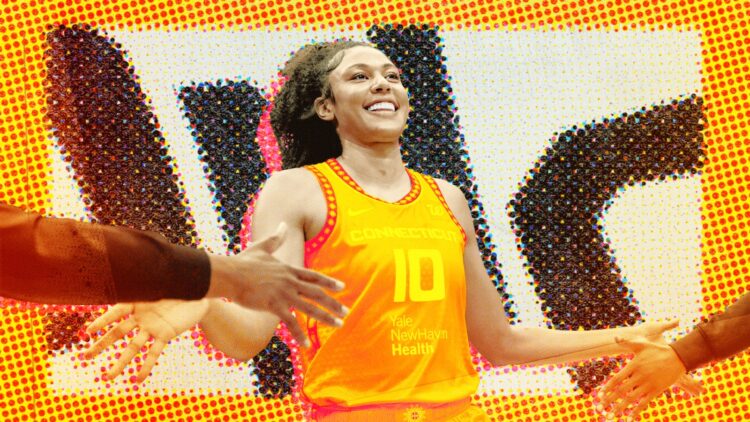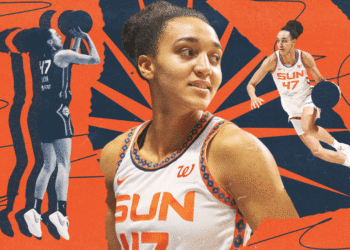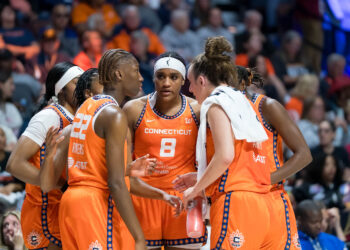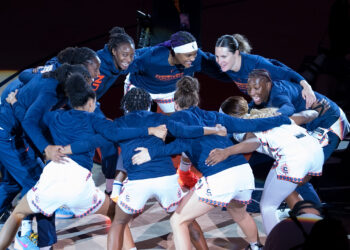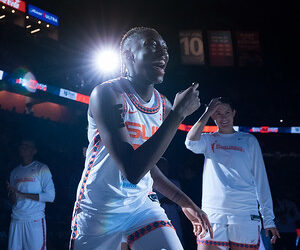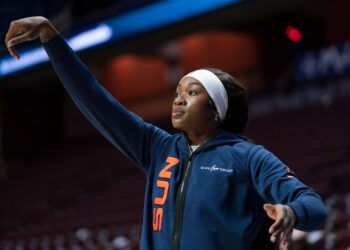From the way she carries herself, an outside observer might not realize that Connecticut center Olivia Nelson-Ododa is just another young prospect on a 2025 Sun roster full of them. Now, midway through her fourth WNBA season, the former UConn Husky is only two-and-a-half years older than rookies Aneesah Morrow and Saniya Rivers, and just a few days older than second-year guard Jacy Sheldon. Yet, those three seasons—especially the past two spent with a different, annually contending version of this franchise—have given Nelson-Ododa a perspective her fresh-faced teammates are likely years away from gaining.
“I can’t emphasize enough just how hard [of an effort]it really takes, day in and day out,” Nelson-Ododa said at media day when asked what she’d learned from Connecticut’s departing veteran core. “Days that you don’t feel like showing up—you still have to show up for the team.”
If consistency was the biggest eye-opener on a team that reached the semifinals year after year, then Nelson-Ododa has had to lean on that lesson even more this season, as the Sun grind through what will likely become their first playoff-less campaign since 2016—during Olivia Nelson-Ododa’s junior year at Winder-Barrow High School outside Atlanta.
To her credit, the former “Miss Georgia Basketball” has done just that so far in 2025, growing as a player and contributing to more positive (if not always winning) team basketball, even while adjusting to occasional changes in her role under rookie head coach Rachid Meziane. When he dropped Nelson-Ododa to the bench following the team’s 2–10 start, she didn’t change her attitude—or her performance level.
Her first game off the bench continued her steady form: six points on 3-of-5 shooting, four stocks (steals+blocks), and a +3 plus-minus that reflected the success of the lineups she was part of in an 86–83 loss to Dallas. Forty-eight hours later, she came off the bench again and, despite an 0-of-5 night from the field, remained a net positive—adding six rebounds, three assists, and five blocks, with a -2 plus-minus—in a heavy 24-point loss to Golden State.
By the time the Sun returned to action a few nights later against Las Vegas, Meziane had Nelson-Ododa back in the starting five, presumably as a result of the steady impact she continued to provide (and, in fairness, the challenge presented by Vegas’ size).
That one word—“steady”—perfectly captures the impact Nelson-Ododa has brought this season, even if she’s not the style of player that stuffs the stat sheet every night. Indeed, advanced metrics that go beyond traditional box score numbers underline her influence in a more compelling way, with Nelson-Ododa currently placed at or near the top of the team leaderboards in net rating, win shares, and player efficiency rating.
Throw on the tape from almost any Connecticut game this season, and the why behind the numbers above quickly becomes apparent. In short, this Sun roster—currently ranked 13th in team defensive rating—isn’t built on strong individual defenders. Rivers and a few others (Morrow and Leïla Lacan, for instance) show clear potential, some of which is already starting to shine, but collectively, this group only turns in standout defensive efforts when everyone is fully locked in for the entire game.
And for a team on pace to finish at the bottom of the standings, that level of engagement—unsurprisingly—wavers. Yet Olivia Nelson-Ododa, even in a blowout loss like the one to the Valkyries, consistently looks like one player who maintains focus regardless of score or situation.
The above play, in particular, highlights a player who stays on task and makes multiple efforts across a long defensive possession—even while constantly in motion, both in terms of positioning and matchups. After hedging on a ball screen, Nelson-Ododa picks up Monique Billings on the roll, follows her through a pair of screens, gets switched onto Veronica Burton in space, rotates back to Billings, and finally holds her ground in the paint against a Tiffany Hayes drive—capping it all off with a fingertip rejection.
Aside from the block itself (which is, admittedly, an impressive one), there’s nothing flashy about her work here. But it’s the sticktoitiveness—shown by her and, to be fair, her four teammates—that’s been so often missing from Connecticut’s defense this season.
Take, for instance, the four clips below from that same game—each showing relatively simple rotations—to illustrate the difference in coverage with and without the fourth-year center on the floor:
As you can see, there’s a clear difference in proactiveness when Olivia Nelson-Ododa is on the floor as a weak-side helper—granted, her 6-foot 9-inch wingspan certainly helps. In the first two clips, before she checks in for the first time, the drives go largely uncontested—aside from a solid contest by Sheldon on Hayes’ finish. But even that’s a recovery on her own assignment, with a complete absence of secondary help.
Morrow, in particular, is the low man and never fully commits to stopping the drive. She doesn’t rotate but keeps a foot in the paint—meaning a closeout to Billings in the corner, a sub-20 percent three-point shooter, was never likely to arrive in time anyway. In the second clip, all three defenders not involved in the screen-and-roll fail to react. Tina Charles, like Morrow, is caught in between—neither tight to her shooter at the top of the arc nor engaged enough as a helper to aid Bria Hartley.
Golden State, of course, deserves credit for how well it spaces the floor. But the five-out look remains constant in the next two clips, where Nelson-Ododa is on the floor. The difference is her willingness to fully commit to helping—even if it risks giving up a clean look to her original match-up. And that, truthfully, is a core tenet of being an effective low man and rim protector.
If you hesitate defensively, you won’t make weak-side plays. And if you don’t trust your teammates to adequately scramble behind you when you do commit, plays like the rejection in the third clip simply don’t happen.
Of course, there’s always an element of cherry-picking when using a small set of plays from a single game to illustrate a player’s value across an entire season. Nelson-Ododa has, at times, missed rotations this year, and others—like Charles and Morrow—have certainly made impactful defensive plays of their own.
Still, the advanced defensive numbers referenced above—especially when compared to someone like Charles—tell a clear story about the consistency Olivia Nelson-Ododa has brought. And she’s not just flashing that impact in isolated moments; there’s ample evidence throughout the season that she’s been Connecticut’s single most important contributor on the defensive end.
That defensive level is, no doubt, a product of the consistent approach Nelson-Ododa identified as her biggest takeaway from Sun legends like Alyssa Thomas and DeWanna Bonner. Yet, it’s not the only area of the game where—backed by that show-up-for-the-team attitude—she’s made a meaningful impact. Rebounding, for instance, has been a clear area of growth, as she’s improved on her 2024 numbers while anchoring the Sun’s broader efforts on the glass.
With her playing time nearly doubled this season (23.5 minutes per game, up from 11.8), a jump in counting stats was to be expected—Nelson-Ododa has increased her rebounding average from 2.5 to 6.3 boards per game. But a variety of minutes-adjusted metrics show that her growth reflects improved performance, not just a bigger role.
On a per-100 possessions basis, she’s averaging 13.9 rebounds, up from both her 2024 mark of 11.2 and her previous career high of 12.7 in 2023. Only Morrow and fellow rookie Rayah Marshall (who’s logged just 49 total minutes) rank higher among Sun players. League-wide, Nelson-Ododa’s per-100 rebound rate ranks in the top 25.
She also places similarly high in rebounding percentage (15.7 percent), well ahead of her career-best mark of 14.7 percent from that same 2023 season.
In other words, Nelson-Ododa’s work on the glass is creating real value—particularly on the offensive end, where one in every five of Connecticut’s second-chance opportunities begins with one of her rebounds. For a team that ranks just 10th in the league in second-chance scoring (10.0 points per game), that may not seem like a major impact at first glance. But it becomes far more meaningful when you consider the context: the Sun rank last in the WNBA—by nearly seven points per game—in overall scoring. On a percentage basis, they actually sit fifth league-wide in how much of their total offense (14.0 percent) comes from second-chance points. That reliance makes Nelson-Ododa’s contributions in these less glamorous areas—”hustle stats,” if you will—all the more vital to what success this team has managed to scrape together this season.
In the end, the value Nelson-Ododa brings across multiple areas makes a strong case for her being just as central to Connecticut’s future as the more widely discussed rookie trio of Morrow, Rivers, and recent arrival Leïla Lacan (a 2024 first-round pick). With only five players—those three, plus Marshall and Sheldon—under contract for 2026, the restricted free agent rights the Sun hold on Nelson-Ododa next winter will become all the more valuable—especially for a franchise that, as last winter’s veteran departures made clear, has work to do to establish itself as a premier free agency destination.
And while the jury may still be out on Meziane’s future as the Sun’s head coach—as his team limps toward the midway point of the season—one goal he’s emphasized from day one is the importance of building a clear, sustainable culture. At media day, Meziane spoke of “rebuilding the culture” as part of a “new cycle,” highlighting a key objective: to “fight hard every game.”
Olivia Nelson-Ododa is uniquely positioned to embody that vision, as one of the last remaining players (alongside 2024 midseason arrival Marina Mabrey) with first-hand experience of the standards and effort that carried this franchise to seven postseason series wins over the past six seasons.
Her growth as a player and her unwavering effort—even in moments when the team’s collective intensity has waned—suggest she not only understands what it takes to carry that standard forward, but has the capacity to be one of the leading faces of the Sun’s new era—both through her on-court production and the example of consistency she’s passing down to others.
All stats as of July 12. Unless otherwise noted, all stats courtesy of Basketball Reference and WNBA.com.
